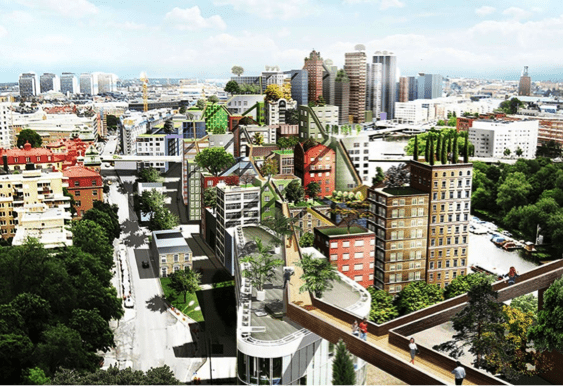5 Exciting Career Opportunities in the Built Environment for 2016
Posted on: 13 January, 2016
The Built Environment is a large, diverse and exciting industry with traditional areas such as construction, property, and land surveying being included. Professions within the Built Environment consist of design, engineering, surveying, management and planning.
There is huge opportunity for school leavers, recent graduates, and current professionals to grow their career within the industry. According to the Department for Business Innovation & Skills, the construction industry alone makes up 10 per cent of jobs in the UK.
There are a variety of professions available to those seeking a career within the industry; we look at what some of the career paths are and what they entail.
Design
Design in the Built Environment involves professions such as ‘Architect’ or ‘Urban Designer’. Architecture is a very practical and creative field to work in, coming up with imaginative new buildings designed to meet the needs of users and the environment, as well as solutions for restoring or reusing old buildings. The role of an architect can also encompass other specialities such as an architectural technologist – a specialist in the science of architecture.
Urban design is the process of shaping cities, towns and villages. This will involve analysing existing spaces and working out how to improve them. A recent example of a pioneering new urban design project includes a soaring green sky walk park in Stockholm. Commissioned by Stockholm Centre Party to design a new neighbourhood on top of the train tracks next to Stockholm Central Station, its vision is a city with thin towers constructed at staggered heights with plenty of foliage and natural light.
Image courtesy of inhabitat – Pioneering new urban design in Stockholm
Engineering
Engineers in Construction are involved in creating connective infrastructure such as bridges, roads or systems of distribution for utilities such as gas, water and electricity; providing structural solutions helping buildings withstand extreme weather and heavy loads.
Within construction there are three main types of engineers: Civil Engineer, Structural Engineer and Building Services Engineer.
Civil and Structural Engineers have to consider how to make a building or structure stand up. The shape of the building or structure affects how strong it is. Building Services Engineers are at the forefront of the climate change challenge, developing new technologies and ground-breaking research such as intelligent buildings.
According to Environment Leader, 10 intelligent building trends to watch in 2016 include;
- Smart cities will drive the development of intelligent buildings
- Hardware and software analytics will improve health in buildings
- Cyber security is set to be a key differentiation between intelligent building solutions and the energy cloud will redefine buildings as energy assets.
Surveying
Surveying is a huge area of work and surveyors are essential to the development and construction of new and existing buildings by providing expertise and advice to clients, and the design team.
- Land Surveyors advise on the features of a particular piece of land by providing accurate measurements of natural and man-made structures
- Quantity Surveyors manage and advise on all of the costs of a construction project
- And finally, Building Surveyors provide professional advice on the design, maintenance, repair and refurbishment of buildings
Management
Most industries employ managers to ensure that work is completed to an agreed timescale, budget and level of quality. Managers have high levels of responsibility including managing people and resources. In relation to the construction industry there are many types of manager, these can include:
- Project Managers – bring about the successful completion of a project. A ‘project’ could be coordinating anything from a relatively small-scale building like the conversion of a loft in a house, right up to a huge project such as building the Olympic Park
- Construction Managers – run building sites, liaise with architects, planners, engineers, surveyors, trades people and suppliers to ensure that projects are completed safely and on time and on budget
- Facilities Managers – once a construction project is complete, Facilities Managers are employed to make sure that buildings and their services meet the needs of their users as efficiently, safely and cost effectively as possible.
Planning
Planners manage the use of space in towns and the countryside on everyone’s behalf. They have a challenging role in trying to encourage new development while considering the environmental and social impacts.
A Town Planner’s role may involve consulting local residents, businesses and other stakeholders over planned development, reviewing and commenting on proposals for new buildings, and developing new strategies for how an area should develop. A large part of this can also be assessing building sustainability.
Earlier this year, we were pleased to announce our partnership with the Prince’s Foundation for Building Community (Prince’s Foundation). The collaboration set out to teach and share content to educate students in ways of planning, designing and building in timeless, ecological and sustainable ways.
A recent example of a sustainable building is Rio de Janeiro’s new museum, funded by the Rio City Government, with support from sponsors, the building attempts to set new standards of sustainability. Compared with conventional buildings, designers say it uses 40 per cent less energy (including the 9 per cent of its power it derives from the sun), and the cooling system taps deep water from nearby Guanabara Bay.
An industry of opportunity
In the words of Peter Hansford, Government Chief Construction Adviser, “The industrial strategy for construction, Construction: 2025, sets out the vision of a smart industry that is efficient and technologically advanced. With a tidal shift in how we are creating and caring for our assets, it is essential that we build solid digital foundations where we can unlock the prize of a global construction market forecast to grow by over 70 per cent by 2025.”
Now is a great time to join the industry and progress your professional ability through training and education. The future is bright – the future is the Built Environment.
For more information on the opportunities available to you by studying with UCEM, please contact enquiries@cem.ac.uk and visit our website.
References:
- Built Environment 2050 – A Report on Our Digital Future report (BIM2050 and Construction Industry Council)
- A Professional Career in the Built Environment – A report by Construction Industry Council







